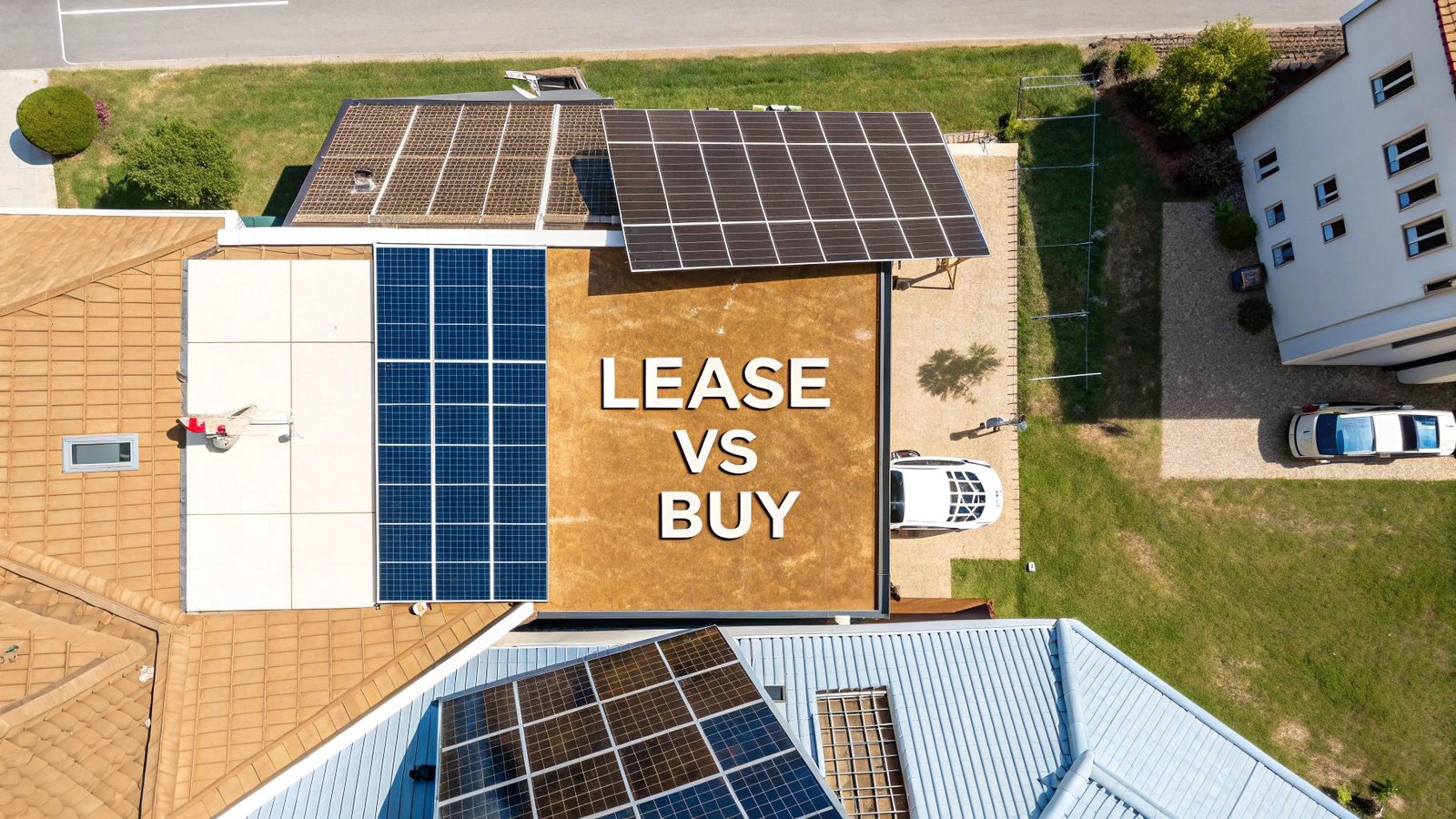Thinking about going solar? The first question on everyone's mind is usually, "How many panels do I actually need?" A solar system sizing calculator is the tool that answers that exact question.
Think of it as a digital blueprint for your future solar setup. It takes your unique energy use, your home's location, and even your roof's specifics to give you a solid estimate of the ideal system size. It’s the essential first step that clarifies your needs and potential savings long before you start talking to installers.
Why a Solar Calculator Is Your Best First Move

Jumping into solar without a plan is a recipe for disappointment. A one-size-fits-all approach just doesn't cut it because every household is different. This is where a good solar calculator proves its worth.
These tools take the guesswork out of the equation. Instead of vague estimates, you get a data-driven recommendation that acts as a reliable baseline when you start gathering quotes and having conversations with solar professionals.
The Dangers of Guessing Your System Size
Without a proper calculation, you’re likely to run into one of two costly problems:
- Undersizing: You install a system that’s too small to cover your needs. The result? You're still paying a significant power bill every month, and your return on investment never quite materializes.
- Oversizing: You end up with a system that’s far too large for your home. This means you’ve overpaid for panels you don't need, which can be a real financial drag, especially if your local utility doesn't pay you much for the extra energy you export to the grid.
graph TD
A[Incorrect Sizing] --> B{Undersized};
A --> C{Oversized};
B --> B1[Still Paying High Utility Bills];
B --> B2[Poor Return on Investment];
C --> C1[Overpaid for Unneeded Panels];
C --> C2[Low Value for Excess Energy Exported];
subgraph "Ideal Outcome"
D(Correctly Sized) --> D1[Maximized Savings];
D --> D2[Optimal Return on Investment];
end
style B fill:#f99,stroke:#333,stroke-width:2px
style C fill:#f99,stroke:#333,stroke-width:2px
style D fill:#9f9,stroke:#333,stroke-width:2px
A sizing calculator helps you find that "Goldilocks" zone. It points you toward a system that’s just right for your energy goals and budget, ensuring you get the most bang for your buck without wasting money.
At its core, the goal is to match your home's power consumption with the solar energy you can realistically generate. For example, the calculator starts by looking at your monthly electricity usage, which you can find right on your utility bills.
Let's say your home uses about 900 kWh per month. In an area that gets five solid hours of peak sunlight daily, a quick calculation would suggest you need a 6 kW system (30 kWh/day ÷ 5 hours/day). It's this kind of tailored math that makes all the difference.
Of course, a big part of the appeal of solar is its environmental benefit. To really appreciate how much of a difference you can make, it helps to understand the concept of a carbon footprint, which solar power dramatically reduces. Sizing your system correctly ensures you're making the biggest possible positive impact.
Gathering Your Home's Energy Data
A solar calculator is a fantastic tool, but it's only as smart as the numbers you give it. To get a truly accurate estimate for your home, you need to start with a solid understanding of your actual energy usage. The best place to find this is right in your mailbox or inbox: your past electricity bills.
Dig out your last 12 months of utility statements. Most power companies include a handy chart or section that breaks down your usage history. You're looking for one key number: your monthly consumption in kilowatt-hours (kWh). This is the bedrock of any good solar calculation.

Add up the kWh from all 12 statements to get your total annual usage. This yearly figure is crucial because it smooths out the seasonal spikes—think running the AC nonstop in August or firing up the electric heat in January. It gives you the complete picture.
xychart-beta
title "Example Monthly Electricity Usage (kWh)"
x-axis [Jan, Feb, Mar, Apr, May, Jun, Jul, Aug, Sep, Oct, Nov, Dec]
y-axis "Usage (kWh)" 0 --> 1500
bar [650, 600, 700, 850, 950, 1100, 1300, 1400, 1150, 900, 750, 700]
Don't Forget to Plan for the Future
Your past energy use is a great starting point, but it's not the whole story. I've seen homeowners undersize their systems because they didn't think about what was coming next. That's an expensive mistake to fix down the road.
Take a moment to think about any big changes on the horizon. Are you planning on any of these?
- Buying an Electric Vehicle (EV): This is a big one. Charging an EV at home can easily increase your household electricity consumption by 30% or even more.
- Expanding Your Home: Finishing a basement or building an addition means more lights, more outlets, and more space to heat and cool.
- Adding Major Appliances: Thinking about a hot tub, a pool, or finally installing central air? These are serious energy hogs that need to be factored in.
By estimating these future needs and adding them to your current usage, you're giving the calculator the data it needs to design a system that won't just work for you today, but for years to come.
If you want to dive deeper into the math behind it all, check out our guide on how to calculate solar panel needs. Once you've got a handle on your current and future energy numbers, you're ready for the next step.
Alright, you've got your energy usage numbers. Now comes the part where we look at your actual home and the weather it sits in. This is where a good solar system sizing calculator really starts to shine, because it’s not just about how much power you use, but how much power you can realistically make.
Where you live is a massive piece of the puzzle. Think about it: a system in Phoenix, Arizona is going to get a whole lot more sun than the same exact system up in Portland, Oregon. That's why every calculator will ask for your zip code. It's not being nosy—it's using that info to look up the "peak sun hours" for your specific spot on the map. This is basically a measure of how much quality, direct sunlight you can expect.
xychart-beta
title "Average Daily Peak Sun Hours by City"
x-axis ["Phoenix, AZ", "Miami, FL", "Denver, CO", "Chicago, IL", "Portland, OR"]
y-axis "Hours" 0 --> 8
bar [6.5, 5.2, 5.0, 4.3, 3.8]

What About Your Roof and Pesky Shadows?
Beyond the weather, your roof is the next big variable. Its direction and angle (or pitch) are critical. If you're in the Northern Hemisphere, a roof that faces south is the ideal canvas for solar panels, as it soaks up the most sun throughout the day.
But then you have to play detective and look for shadows. Anything that blocks the sun from hitting your panels is going to cut into your production. Walk around your property and be brutally honest about what you see:
- Trees: Are there big, leafy trees that will throw a shadow over your roof, especially when the sun is at its strongest?
- Other Buildings: Does your neighbor's two-story house block the morning or afternoon sun?
- Your Own Roof: Even things like chimneys, vents, or a satellite dish can create small shadows that impact performance.
I can't stress this enough: don't ignore shade. Even a small shadow on a single panel can drag down the output of every other panel connected to it in that string. Being accurate here will save you from a disappointing production report later on.
It’s not just about your physical property, either. Local rules and utility policies can play a role. For instance, some utilities in California might put a cap on how big your system can be, while states like Massachusetts have specific exemptions for systems under a certain size.
The more sophisticated calculators, like the PVWatts Calculator from NREL, are great because they bake all of this in—your roof's direction, shading, and even local data—to give you a much clearer picture of what to expect. If you want to dive deeper into how this all comes together, you can learn more about solar interconnection and sizing guidelines to really understand the nitty-gritty.
Making Sense of Your Calculator Results
Alright, you've plugged in all your numbers and hit "calculate." What you see next is the roadmap for your home's solar journey. It can look like a lot of technical jargon at first, but let's break down what those numbers really mean for you and your wallet.
The first and most important number to find is the recommended system size. This is measured in kilowatts (kW) and it’s the cornerstone of the whole plan. For a fairly standard single-family home, you might see a recommendation for something like a 6.5 kW system. This single figure determines almost everything else that follows.
The Key Numbers to Focus On
From that main system size, the report will give you a few other critical pieces of information. Here’s what to look for and what it means in the real world:
-
Estimated Annual Production: This is the big one for savings. Measured in kilowatt-hours (kWh), it tells you how much power your panels will likely crank out over a full year. This is the electricity you won't have to buy from the utility company.
-
Number of Solar Panels: This turns the abstract "kW" size into something tangible. For that 6.5 kW system, the calculator might estimate you'll need anywhere from 15 to 22 panels on your roof, depending on the specific model and its efficiency.
-
Energy Offset: You'll usually see this as a percentage. It's a simple way of showing how much of your current electricity bill the new solar system will cover. A 95% offset, for example, means you're generating nearly all the power you consume.
Think of these results as your baseline. When you start getting quotes from installers, you can use these numbers to make sure their proposals are a good fit for what your home actually needs.
For a little perspective, the average home solar system in the U.S. is right around 7.13 kW. That usually means installing between 16 and 25 solar panels. All these individual home systems add up, contributing to a massive nationwide residential solar capacity of over 33,700 megawatts.
Ultimately, it all comes down to the connection between system size and energy production. The more power your system can generate, the closer you get to energy independence. If you want to dive deeper into the basics of how this all works, our guide on how does home solar work is a great place to start.
Turning Your Calculation into an Installation

The numbers from a solar system sizing calculator are an fantastic starting point, but they're not the final word. It's best to think of them as your entry ticket into a serious conversation with a professional installer. When you have a solid estimate of your system size, you walk into those discussions feeling informed, not just hopeful.
This baseline is also your best tool for comparing quotes. You'll be able to quickly see if one company's proposal is way out of line with the others. If someone suggests a system that’s drastically larger or smaller than what your initial research showed, you'll know to dig in and ask why.
The Professional Site Assessment
This is where the rubber really meets the road. No calculator, no matter how advanced, can see the unique reality of your property. That's a job for an experienced installer during an on-site assessment.
During this visit, a pro will get hands-on with the specifics of your home, including:
- Verifying Roof Condition: Is your roof new enough? Is the structure sound enough to hold the weight of a full solar array for decades? They'll find out.
- Confirming Shading Details: They won't just eyeball it. Installers use specialized tools to map out exactly how that big oak tree or your neighbor's second story will cast shadows across your roof, month by month.
- Inspecting Your Electrical System: They'll pop open your main electrical panel to make sure it can safely handle the new power coming in from the panels.
This in-person checkup is what turns your ballpark estimate into a concrete plan of action.
Your calculator results give you the "what" (the system size), but the professional site visit determines the "how" (the specific design and installation plan). This step is non-negotiable for an accurate and safe installation.
Finalizing Your Project
Once you have a professional quote built on that site assessment, you can start layering in the final pieces of the puzzle. This is the time to decide if you want battery storage for power outage protection—a decision that has its own sizing considerations.
Your installer will also be your guide through the maze of local rebates, tax credits, and utility net metering programs. These financial details are just as important as the hardware. Combining all this with a clear picture of the total solar panel system installation cost gives you everything you need to confidently sign on the dotted line and bring your solar project to life.
Got Questions? Let's Talk Sizing
Even the best solar calculators can leave you with a few lingering questions. That's perfectly normal. Based on my experience helping homeowners go solar, here are a few of the most common things people ask after getting their initial estimate.
Just How Accurate Are These Online Tools?
Think of a solar calculator as a fantastic starting point. They're surprisingly good, using solid local weather data and standard formulas to get you in the right ballpark. But they can't see the specific quirks of your property—like the big oak tree that shades your roof after 3 PM or that your south-facing roof has a tricky vent pipe right in the middle of the prime real estate.
The number you get is a solid, well-informed estimate. A professional installer will build on that with an on-site visit to nail down the final, precise design.
The calculator gives you a roadmap; the professional site assessment confirms the exact destination. You really need both for a perfect solar journey.
What if I Plan on Using More Power in the Future?
Great question. This is where you get to be proactive. If you've got an electric vehicle on your wish list, or you're thinking about swapping out your gas furnace for a heat pump, you'll want to account for that now.
Most good calculators let you adjust your electricity usage. Go ahead and estimate that future increase in kilowatt-hours (kWh) and plug it into the tool. It's almost always cheaper and easier to build the system you'll need for tomorrow, today. Adding a few extra panels later on can be a much bigger headache than just getting it right from the get-go.
Do These Calculators Account for Battery Storage?
Some do, some don't. The more sophisticated calculators will have a toggle or a specific section where you can factor in a home battery. If you're keen on having backup power for outages or want to store your solar energy to use at night (a huge plus if your utility doesn't pay much for the excess power you send back), you'll want to find a tool with this feature.
If the calculator you're using is a bit more basic, don't worry. Just use its main recommendation for the solar panel array size. Then, when you talk to an installer, you can dive deep into battery options. They can show you exactly how different battery sizes would pair with your system to meet your goals.
Ready to turn that estimate into a real plan? The team at Radiant Energy can give you a free, no-obligation quote based on a detailed look at your actual home. Get your personalized solar plan today!




